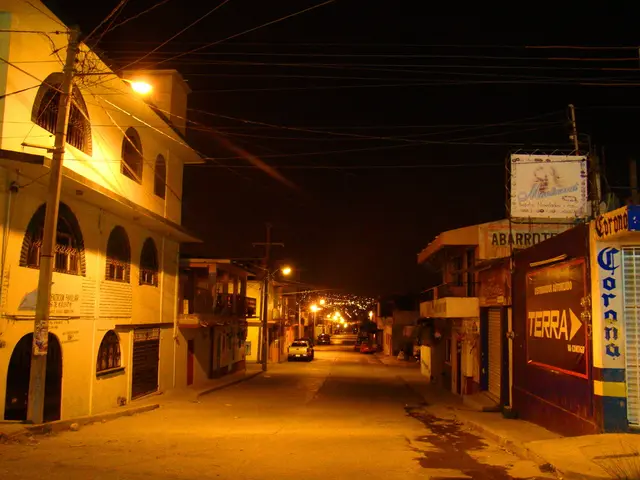Thailand's growing LNG industry takes a toll on coastal towns and villages
In the coastal province of Rayong, Thailand, the expansion of liquefied natural gas (LNG) infrastructure is causing significant environmental and health impacts. The construction and operation of LNG terminals, as well as increased LNG shipping traffic, disrupt marine ecosystems, leading to reduced marine biodiversity and fish populations. This negatively affects local fisheries and livelihoods, and threatens local tourism, as pollution taints areas once known for their natural beauty [1][2].
The province, which hosts several coal-fired power plants and petrochemical facilities, has become a hub for LNG imports. Thailand, the largest consumer of natural gas among ASEAN countries, is increasingly reliant on LNG imports from the Middle East due to declining supplies from the Gulf of Thailand and Myanmar [3].
The pollution and contamination in Rayong have been causing some aquatic animals to dwindle in number and size, affecting local fisherfolk and potentially the tourism industry. Exposure to PM2.5, a pollutant emitted by LNG power plants, has been linked to a range of cancers [4].
These environmental degradations have prompted calls for stricter regulation and faster transition to cleaner energy. Public opposition and legal challenges related to environmental concerns have also emerged as LNG projects expand [4].
To reduce these negative impacts, Thailand is pursuing several alternatives and mitigation strategies. Carbon Capture and Storage (CCS) technology is a key component of Thailand's strategy to reduce greenhouse gas emissions by capturing CO2 from industrial sources before it enters the atmosphere. Thailand's adoption of CCS demonstrates commitment to both energy security and sustainable development while balancing industrial growth with environmental responsibility [3].
Broader energy transition efforts emphasize reducing reliance on fossil fuels altogether by promoting renewable energy and improving energy efficiency, aligning with Thailand's net-zero ambitions [5]. Innovations in LNG technology itself also aim to improve environmental performance, such as more efficient liquefaction, floating LNG terminals, and AI-based monitoring systems to reduce operational emissions and leaks, but these alone do not eliminate community-level environmental concerns [4].
Japan is one of the largest investors in LNG production in Southeast Asia, and PTT has been looking to trade LNG to meet the rising demand coming from China and other Asian countries [2]. However, the current LNG terminals supply Japanese-backed power plants, and LNG's production and use still carry serious environmental risks [1].
Campaigners are calling for the government to focus on renewables as an alternative to natural gas, citing the need to protect local communities and the environment [3]. Groups like EARTH are pushing for the government to establish a Pollutant Release and Transfer Register law, which would mandate companies to report the quantities of chemical substances they release, including to the public [4].
Thailand aims to increase the share of renewable electricity to 74% of total electricity generation by 2050, from 15% as of April 2025 [5]. Plans are underway to install more gas turbines and build a third LNG terminal in the town of Map Ta Phut in Rayong by 2029 [3].
In 2021, China Petroleum Pipeline Bureau Engineering Co and China Petroleum Engineering won a bid to replace Thailand's first LNG plant in Rayong with a new one [2]. As Thailand navigates its energy future, striking a balance between economic growth and environmental responsibility will be crucial.
References:
[1] "LNG's Environmental Risks in Thailand: A Case Study of Rayong Province." EARTH, 2021.
[2] "Thailand's LNG Expansion: Balancing Energy Needs and Environmental Concerns." Energy Insider, 2021.
[3] "Thailand's Energy Outlook: Towards a Sustainable Future." International Energy Agency, 2020.
[4] "Rayong Communities Fight for Clean Energy: A Look at the Legal Challenges." The Nation, 2021.
[5] "Thailand's Net-Zero Ambitions: A Roadmap for a Sustainable Energy Future." Climate Action Network, 2020.
- Concerns about environmental and health impacts have arisen from the expansion of LNG infrastructure in Rayong, Thailand, due to disruptions in marine ecosystems and reduced marine biodiversity.
- The province, which hosts several coal-fired power plants and petrochemical facilities, is a hub for LNG imports, making Thailand increasingly reliant on LNG imports from the Middle East.
- Stricter regulation and a faster transition to cleaner energy are being advocated as solutions to tackle the negative impacts associated with LNG use.
- Thailand is adopting Carbon Capture and Storage (CCS) technology and promoting renewable energy as part of its strategy to reduce greenhouse gas emissions and align with its net-zero ambitions.
- Campaigners are urging the government to focus on renewables as an alternative to natural gas to protect local communities and the environment.
- Achieving a sustainable energy future for Thailand will require finding a balance between economic growth and environmental responsibility, taking into account the need to protect biodiversity and address climate-change concerns.




